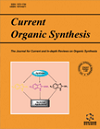- Home
- A-Z Publications
- Current Organic Synthesis
- Previous Issues
- Volume 19, Issue 4, 2022
Current Organic Synthesis - Volume 19, Issue 4, 2022
Volume 19, Issue 4, 2022
-
-
Transition Metal Catalyst, Solvent, Base Free Synthesis of Diaryl Diselenides under Mechanical Ball Milling
More LessAuthors: Debasish Kundu, Anup Roy and Subir PanjaA convenient, efficient, and general procedure for the synthesis of diaryl diselenides has been developed by the reaction of aryl diazonium tetrafluoroborates and potassium selenocyanate on the surface of alumina under ball-milling in the absence of any solvent, transition metal catalyst, and base in room temperature. A wide range of functionalized diaryl diselenides are obtained in high purity and high yield by th Read More
-
-
-
Ag-catalyzed Multicomponent Synthesis of Heterocyclic Compounds: A Review
More LessAuthors: Roghayeh H. Nia, Manouchehr Mamaghani and Fatemeh TavakoliThe investigation of the procedures for the multi-component synthesis of heterocycles has attracted the interest of organic and medicinal chemists. The use of heterogeneous catalysts, especially transition metal catalysts in organic synthesis, can provide a new, improved alternative to traditional methods in modern synthetic chemistry. The main focus is on the utilization of silver as a catalyst for the multi-component synthesis of h Read More
-
-
-
Synthetic Approaches to the Total Synthesis of Tubulysin and its Fragments: A Review
More LessAuthors: Nosheen Iqbal, Ameer F. Zahoor, Nasir Rasool, Samreen Gul Khan, Rabia Akhtar and Raheel AhmadBackground: Tubulysins, linear tetrapeptides, show extraordinary cytotoxicity against various cancer cells, with IC50 values in the nano or picomolar range. Due to their extremely vigorous anti-proliferative and antiangiogenic characteristics, tubulysins exhibit captivating prospects in the development of anticancer drugs. This review focuses on diverse routes for the total synthesis of natural and synthetic tubulysins as well Read More
-
-
-
Ionic Liquids: Environment-friendly Greener Solvents for Organic Synthesis
More LessConstituted by ions, ionic liquids (ILs) are evolving as greener solvents for many organic syntheses. Due to their high solvent power and low volatility, ionic liquids are serving as an environment- friendly substitute to conventional volatile organic solvents. The present review introduces ionic liquids as an insight into the diverse recent applications of ILs in organic synthesis.
-
-
-
An Efficient Protocol for the Synthesis of new Camphor Pyrimidine and Camphor Thiazole Derivatives using Conventional and Microwave Irradiation Techniques and In vitro Evaluation as Potential Antimicrobial Agents
More LessAuthors: Entesar A. Hassan, Salem E. Zayed, Al-Hassan S. Mahdy and Ahmed M. Abo-BakrBackground: A series of new pyrimidines and thiazoles containing camphor moiety were synthesized under both conventional and microwave irradiation techniques. Methods: The condensation of camphor either with aminoguanidine or thiosemicarbazide gives the camphor hydrazine carboximidiamide 2 and the camphor thiosemicarbazone 3, respectively. Refluxing of 3 with chloroacetonitrile afforded the camphor thi Read More
-
Volumes & issues
-
Volume 22 (2025)
-
Volume 21 (2024)
-
Volume 20 (2023)
-
Volume 19 (2022)
-
Volume 18 (2021)
-
Volume 17 (2020)
-
Volume 16 (2019)
-
Volume 15 (2018)
-
Volume 14 (2017)
-
Volume 13 (2016)
-
Volume 12 (2015)
-
Volume 11 (2014)
-
Volume 10 (2013)
-
Volume 9 (2012)
-
Volume 8 (2011)
-
Volume 7 (2010)
-
Volume 6 (2009)
-
Volume 5 (2008)
-
Volume 4 (2007)
-
Volume 3 (2006)
-
Volume 2 (2005)
-
Volume 1 (2004)
Most Read This Month
Article
content/journals/cos
Journal
10
5
false
en


